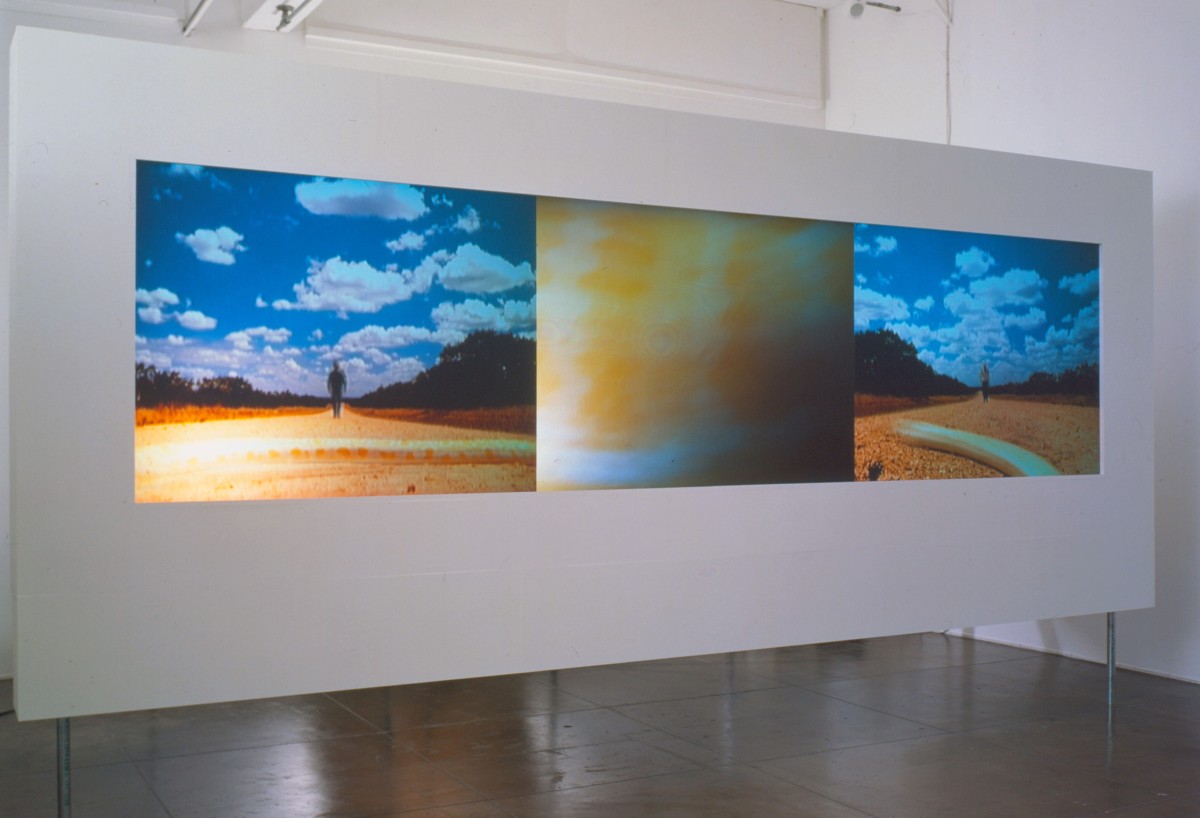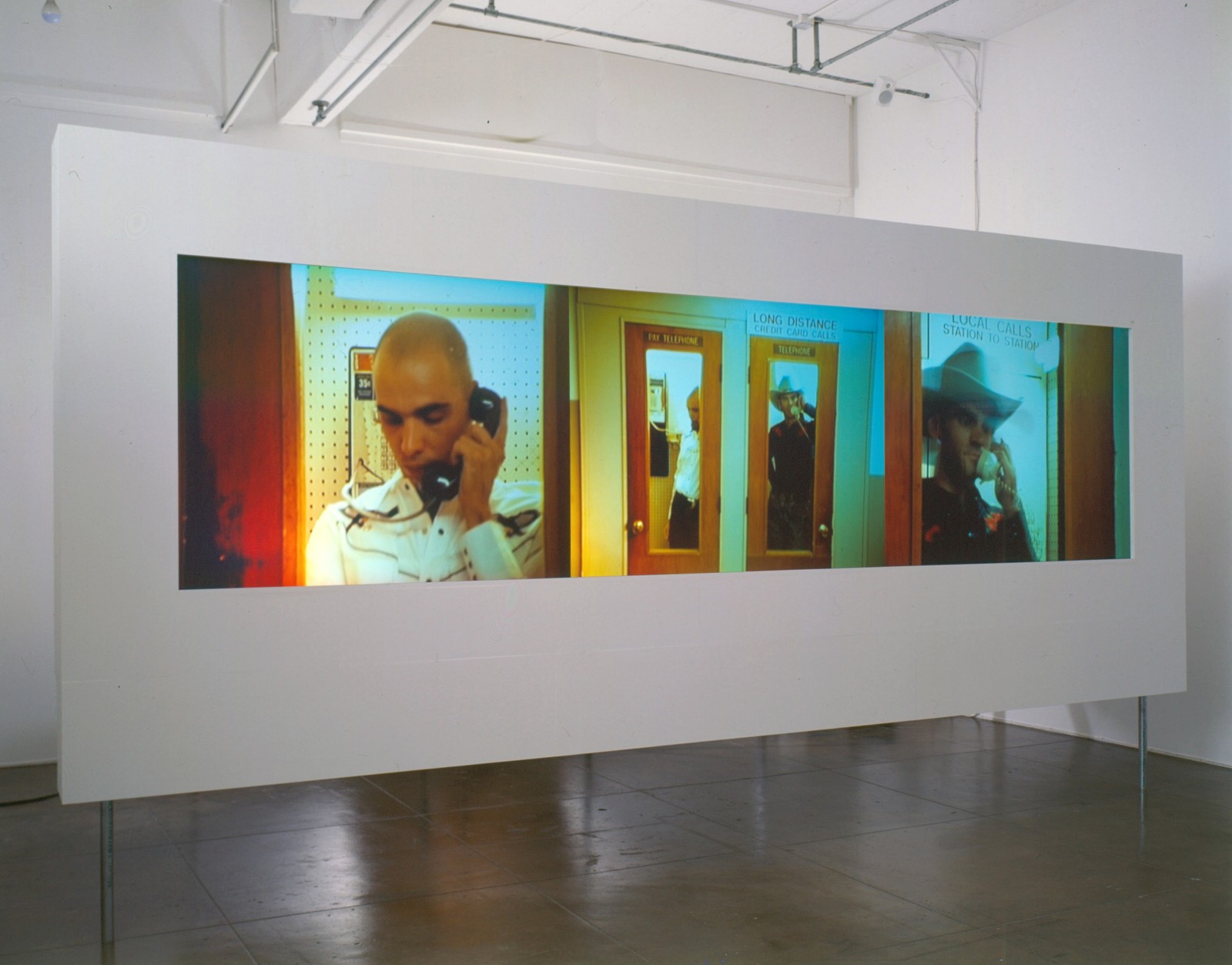The Long Road to Mazatlan at Art PAce
The Long Road to Mazatlán, a video collaboration between Isaac Julien and the choreographer Javier de Frutos, is a fusion of movie and movement, a dance of gazes. Shot in and around San Antonio, it mixes familiar images of the West-the cowboy, the cattle yard, the dirt road-with a more contemporary and homoerotic iconography, unsettling each one. A tale of frustration and loss, the work offers no prescription for stable identity or for the satisfaction of desire, but the sensuality of its images and form is hearteningly seductive.
Julien's descriptions of San Antonio are visually rich, using a saturated color that the regional tourist board might happily borrow for movies of its own. But this is no documentation of some "authentic" local culture. In fact the video is full of displacements, some strong, some subtle. Julien imagines its two main characters (played by de Frutos and Phillippe Riera) as sightseers in the city, despite their cowboy clothes-and tourists might wear those clothes as comfortably as many contemporary Texans. Nor is the cobra that crawls through the opening scene native to Texas. (It is also an albino cobra-an oddity anywhere.) A cowboy yodel on the soundtrack is actually imported from Austria; passages of mariachi music, on the other hand, are performed by local musicians, but are abstracted by repetition, so that a fiddle riff sounds simultaneously ancient and avant-garde.
The most visible displacement is formal: Julien's use of three screens, which abut in a row, fracturing cinema's controlling illusion of a single intact vision. He arranges the projections on these screens in every possible permutation. As the video starts, a long shot of a man walking on a hot Texas road runs across all three screens, its width suggesting a miniaturized version of CinemaScope. The picture soon fragments: now the center screen shows the cobra in the road while the screens to left and right fill with the snake's moving skin, examined so closely that we may need the cue of the center image to identify it. Next the snakeskin shifts to the center screen while the side screens return to the shot of the road, though a different man appears in each one. Elsewhere the screens may show separate parts of the same space (two booths in a bar, say), or the same action from several perspectives, or actions that seem the same but are not. They may repeat identical images in a visual stutter, or pair a shot with its mirror image, or combine in a composite image. That composite in turn may appear whole, or its parts may misalign. The quality of the color, too, may vary from screen to screen, or a sequence may jump into black and white.
His is hardly conventional film syntax, yet rhythmic editing creates a sinuous flow. And The Long Road to Mazatlándoes have a narrative of a kind-boy meets boy, loses boy-although it makes little distinction between actions and interior imaginings, and doesn't so much tell a story as shuffle its components: the preexisting genres, images, and character types of white American culture. That CinemaScope-like opening shot, says Julien, is "very Sergio Leone-I wanted you to feel you were at the movies."1 The two men dress as cowboys, and one wears white, the other black, a classic trope of the western. But Julien and de Frutos are also interested in more recent cowboy imagery, particularly in gay culture of recent decades-so that a scene in a theaterlike cattle-auction hall is inspired by Andy Warhol's Lonesome Cowboys (1968). And just as, in Looking for Langston (1989), Julien remembered the photographs of Robert Mapplethorpe, George Platt Lynes, and James van der Zee, here the paintings of David Hockney inform scenes at an outdoor pool. In fact the whole work has a lush visual texture that Julien calls "painterly."
The video's most explicit quotation is from Martin Scorsese's Taxi Driver (1976), where Robert de Niro asks the mirror, "Are you talking to me?" Julien's man in black plays more goofily with the same moves, but asks a different question: "Are you looking at me?" The Long Road to Mazatlán is intensely sensitized to the act of looking-to people watching each other, or watching movies. What interested Julien about the auction hall, for example, was its resemblance to the panopticon, the prison architecture that Michel Foucault described as a space "observed at every point, in which individuals are inserted in a fixed place, in which all events are recorded, in which power is exercised without division, … in which each individual is constantly located, examined and distributed among the living beings."2
It is a bleak view of human experience, and in fact the title of The Long Road to Mazatlán, a quotation from Tennessee Williams's Night of the Iguana, signifies for Julien and de Frutos an end of the road, a place of no return. As the video closes, the two men perform a jerky, abortive roadside dance-"movements of repression," says Julien, "movements of discombobulated desire." This, apparently, is how desire surfaces when it is relatively unmediated by a borrowed persona, for The Long Road to Mazatlán suggests that we fulfill our desires by mimicking or performing stock roles from the cultural archive available to us. Yet this is less tragic than simply true: the stereotype is intricately embedded in the psyche. "It's the stereotype we find engaging," says Julien, "we depend on it. We're not always undone by stereotypes-in some ways they sustain us."
-David Frankel
1. All quotations of Isaac Julien are from conversations with the author in December 1999.
2. Michel Foucault, Discipline and Punish, trans Alan Sheridan (New York: Pantheon Books, 1977), p. 137.





